Although there are some common patterns to determine the product(s) of a reaction, the exact outcome depends on the type of the reaction. So, let’s discuss the process for the main types of reactions that you are going to see in general chemistry. The first type would be the combination reactions two reactants combine to form one product
Combination Reactions
A combination reaction is a reaction in which two or more substances combine to form a single product. For example,
2NO(s) + O2(g) → 2NO2(g)
2Al(s) + 3Cl2(l) → 2AlCl3(s)
In these examples, the products are given. Now, if they are not, you need to remember the charges of the elements in binary compounds. For example, Zn forms Zn2+ ion, and O forms O2- ion. Therefore, the product between Zn and O2 is going to be the combination of these ions. Remember, to determine the structure of a compound, you need to know what their common charges are. Let’s start with the alkali and alkaline earth metals. These are on the left side of the periodic table – groups 1 and 2 and tend to form cations with charges according to their group number.
For example, all the metals in group 1 such as Na, K, and Li form 1+ cations. The ones in group 2 form cations with a 2+ charge, e.g., Mg2+, Ca2+, and Ba2+. Another good news about these is that their ions inherit the name of the elopement. So, the Na+ ion is called sodium when naming a compound.
Aside from the alkali and alkaline earth metals, there are some transition metals and nonmetals that form ions with predictable charges. For example, Zn forms Zn2+ ion, halogens form anions with 1- charges and take the ending -ide:
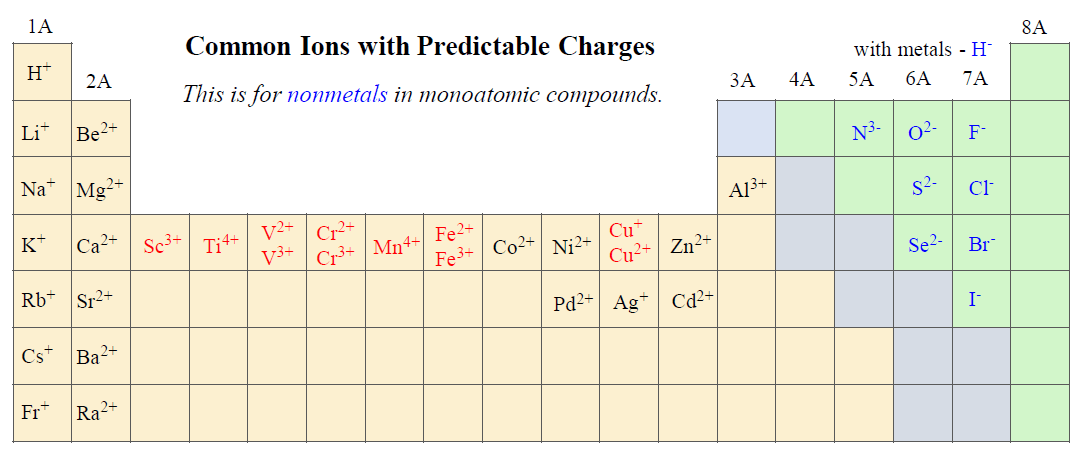
Going back to the reaction between Zn and O2, we can see from the table that Zn forms Zn2+ ion, and oxygen forms O2- ion.
To predict the correct structure of the product, we put them next to each other and cross down the charges to the opposite ion.

Remember, the idea is that the charges must be balanced making a neutral structure. So, for every +, we need a negative charge. In this example, having one of each ion will cancel the charges, and therefore, the formula would be Zn2O2, which we simplify to ZnO. Canceling out the same subscript is always applied except, for example, in peroxides. The formula of hydrogen peroxide is H2O2 and we do not simplify it to HO because in the molecule, there are two hydrogen and two oxygen atoms.
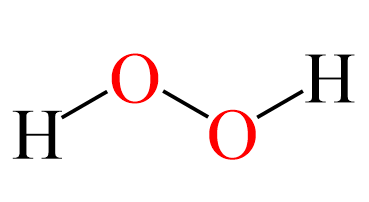
Let’s now determine the product of the reaction between Li and I2.
Li + I2 → ?
The corresponding charges, based on the trends of forming ions, would be Li+ and I–, and therefore, we need to come up with the correct formula of the product for combining Li+ and I– ions.
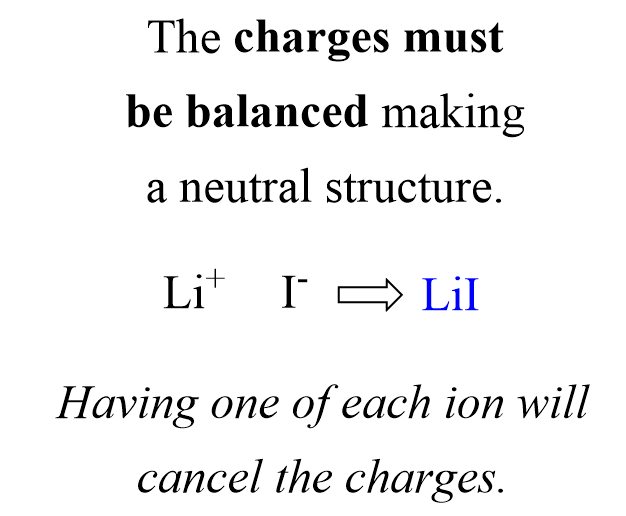
Notice again that we do not write subscript 1. Therefore, the equation for the complete reaction will be written as:
2Li + I2 → 2LiI
Let’s now determine the formula for magnesium iodide. The ions are Mg2+ and I–:

Mg forms the Mg2+ ion, and I2 forms the iodide I– ion, therefore, we have 2+ and 1- charges, and therefore, we need an extra negative charge to make the structure neutral. And we achieve this by combining two iodide ions with one Mg2+:
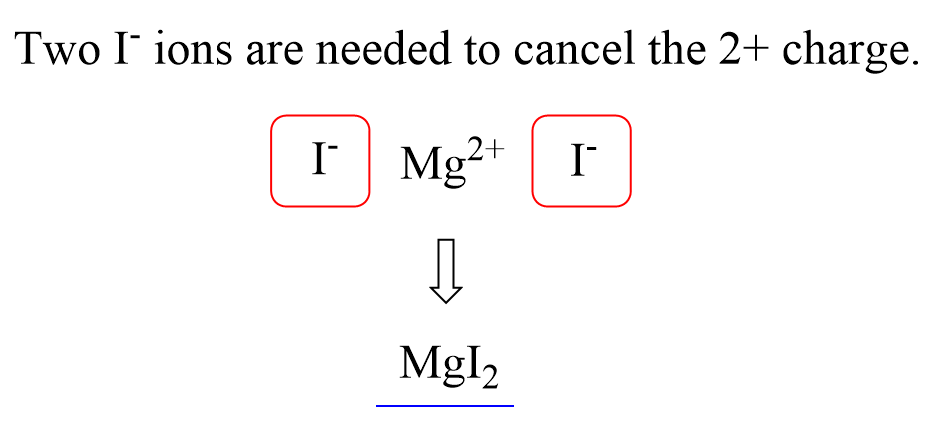
Therefore, the complete reaction can be shown as:
Mg + I2 → MgI2
Another example: what would be the product of the reaction between Ca and N2?
Nitrogen forms nitride ion with a charge of 3-, and therefore, crossing down the charges, we get the formula Ca3N2 – calcium nitride:
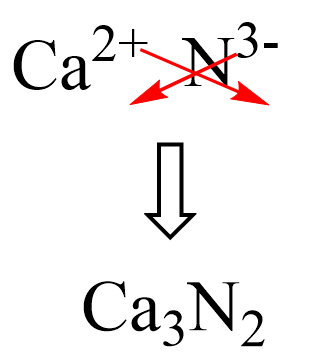
The equation for the reaction would then be written as:
3Ca + N2 ⟶ Ca3N2
Now, all the combination reactions we have disused so far are redo-ox reactions because the oxidation states of the reactants are changing. An example of a combination that is not a redox reaction is:
CaO(s) + H2O(l) ⟶ Ca(OH)2(aq)
Combustion Reactions
Combustion reactions are what we, in everyday life, call burning. It is a type of oxidation reaction, where the substance reacts with oxygen, and because the reaction is very fast and aggressive, it usually releases heat and light to produce a flame.
The combustion of elements forms oxides and to predict their formulas, you need to combine the corresponding ion with the O2- ion just like we did for ZnO.
S (s) + O2 (g) → SO2 (g)
C (s)+ O2 (g) → CO2 (g)
4Al (s)+ 3O2 (g) → 2Al2O3 (s)
For the combustion of organic compounds (those that contain carbon) such as methane (CH4), propane (C3H8), butane (), benzene (C6H6), methanol (CH3OH), ethanol (C2H5OH), etc., the product is CO2 and H2O. For example, the combustion of ethanol can be written as:
C2H5OH(l) + O2 (g) → CO2 (g) + H2O (l)
Don’t forget to balance the equation:
C2H5OH(l) + 3O2 (g) → 2CO2 (g) + 3H2O (l)
Decomposition Reactions
Decomposition reactions are the opposite of combination reactions. In decomposition reactions, a compound breaks down into two or more components. For example,
2KClO3(s) → 2KCl(s) + 3O2(g)
CaCO3(s) → CaO(s) + CO2(g)
Displacement Reactions
A very common type of reaction that you are going to see is what is called a displacement reaction. In a displacement reaction, an ion (or atom) in a compound is replaced by an ion (or atom) of another element. There are a few main types of displacement reactions, so let’s go over them one by one.
Hydrogen Displacement
Some metals are capable of displacing hydrogen (H+) in the form of H2 gas from water and acids. The reactions where hydrogen gas is released by displacing the H+ ions are called hydrogen displacement reactions.
For example, if we react zinc with hydrochloric acid, the hydrogen is displaced in the form of H2 gas:
Zn(s) + 2HCl(aq) → ZnCl2(aq) + H2(g)
Some of the alkali and alkali earth metals can also displace hydrogen from water.
2Na(s) + 2H2O(l) → 2NaOH(aq) + H2(g)
Replacing hydrogen from water is more difficult and there are fewer metals capable of doing it.
To predict whether a metal will be able to displace hydrogen, the activity series (electrochemical series) chart is used.
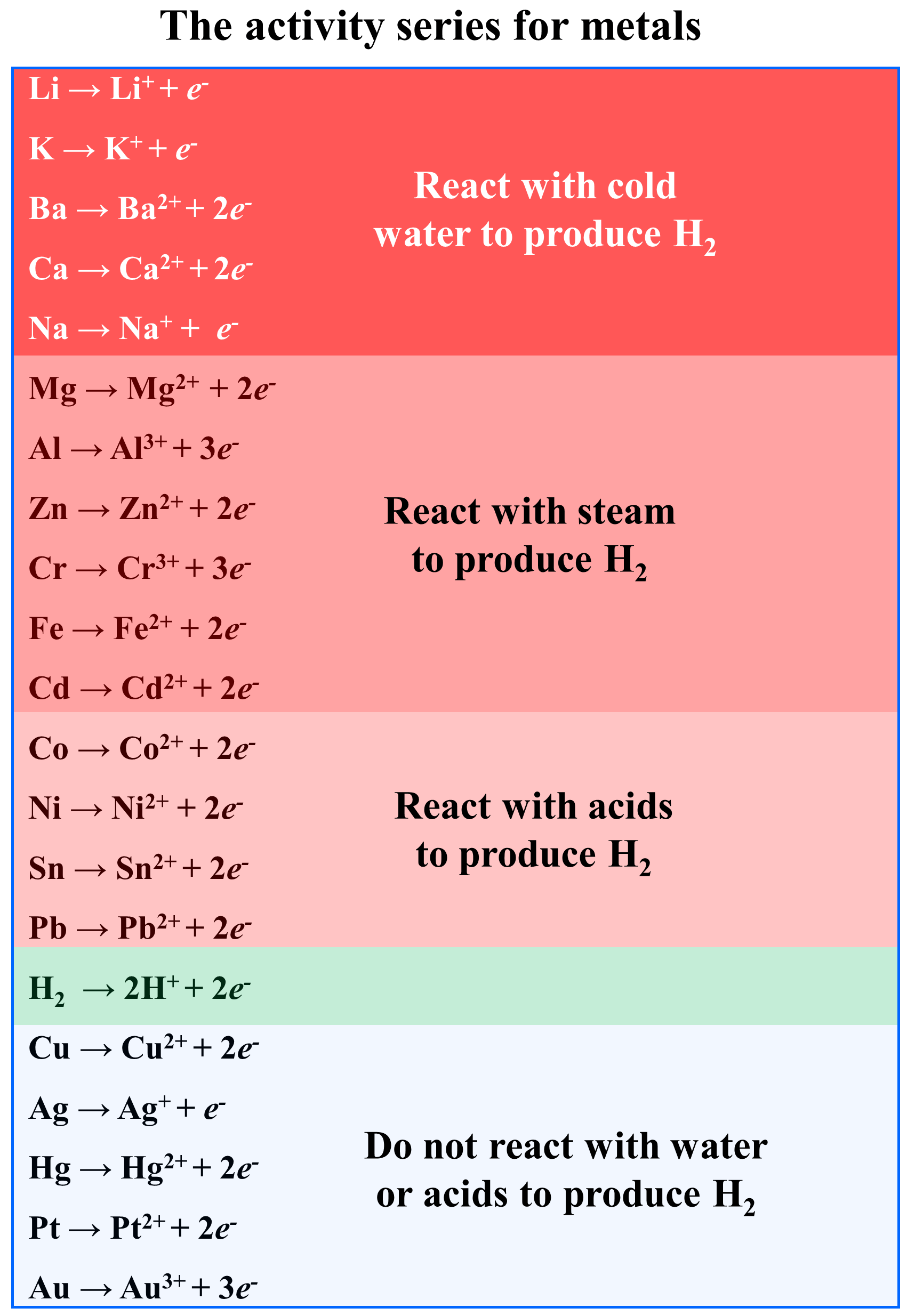
All you need to remember for this is that any metal above hydrogen will displace it from water. The ones that stand below hydrogen, cannot displace it from water and therefore, they won’t react with water.
Li(s) + H2O(l) → LiOH(aq) + H2(g)
Ag(s) + H2O(l) → no reaction
This does not, however, mean that metals below hydrogen cannot react with any acid. They will, but not every time the hydrogen will be the product of the reaction. For example, copper reacts with concentrated nitric acid in the following redox reaction:
3Cu(s) + 8HNO3(aq) → 3Cu(NO3)2(aq) + 2NO(g) + 4H2O(l)
So, the strict borderline for the activity of a metal is whether it reacts with water or not.
While Group 1A(1) metals and Ca, Sr, and Ba from Group 2A(2) readily react with water to displace H2, less active metals can still displace H2 from acids. For example, Ni and even Cu are not as reactive of a metal, but they can still displace H2 gas from acidic solutions with high concentrations.
Metal Displacement Reactions
In metal displacement reactions, a metal in a compound is displaced by another metal that has been reacted in the elemental form. For example, magnesium can displace Co2+ ions from CoCl2 forming MgCl2 salt:
Mg(s) + CoCl2(aq) → MgCl2(aq) + Co(s)
The question is how do we know which metal can displace another metal from a salt?
You need to remember, that the activity series is also used to predict whether the given metal can displace another one. And this again will depend on their position in the activity series. If it stands above the metal in the compound, a displacement reaction will occur, while the reverse reaction won’t be possible.
For example, Zn stands above Cu, so zinc metal will displace copper ions from copper salts.
Zn(s) + CuSO4(aq) → ZnSO4(aq) + Cu(s)
The reverse reaction won’t occur unless external energy is applied which we will discuss in electrochemistry.
Halogen Displacement
Halogens are also capable of displacing another halogen ions in the form of X2 molecules. For example, Cl2 is used to prepare I2 from seawater where iodide ions are present:
Cl2(g) + 2NaI(aq) → 2NaCl(aq) + I2(s)
This is a redox reaction, where Cl2 is the oxidizing agent and I2 is the reducing agent as it is being reduced. If you have not covered the oxidation state, and redox reaction in general, do not worry about this terminology. What you need to remember is that any halogen standing above the other one in the periodic table, can displace it from a compound.
F2 > Cl2 > Br2 > I2
Double-Displacement (Metathesis) Reactions
In the examples above, we have seen that one element displaces another one from a compound. Now, when there are two species changing partners, we call double-displacement or metathesis reactions.
The most common examples of double-displacement reactions are the precipitation reactions which occur when the cations and anions of two compounds are combined and an insoluble compound is formed.
For example, when an aqueous solution of sodium chromate (Na2CrO4) is added to an aqueous solution of silver nitrate (AgNO3), a dark orange precipitate of silver chromate (Ag2CrO4) is formed:
Na2CrO4(aq) + AgNO3(aq) → Ag2CrO4(s) + NaNO3(aq)
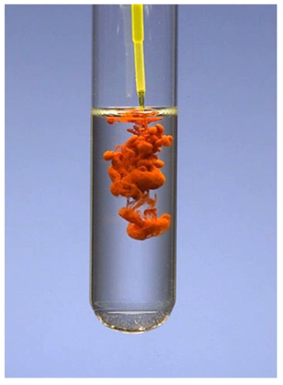
To predict the products of a double displacement reaction, you need to know the formulas and the charges of the ions in the starting materials and use the solubility rules to identify the precipitate in the reaction. The solubility of common ions is summarized in the table below:
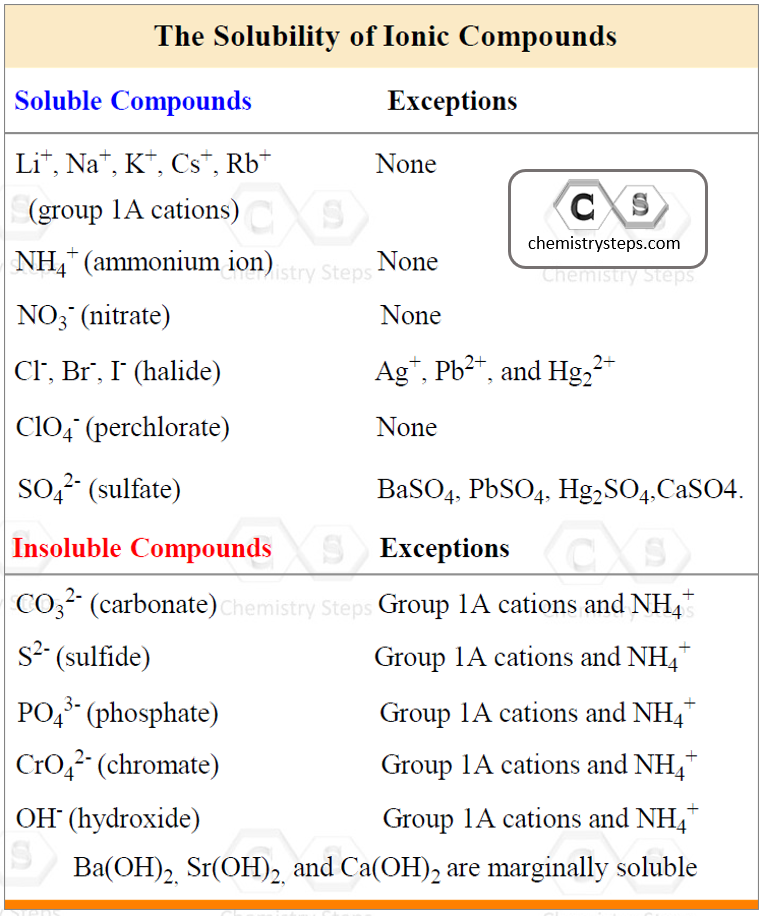
For example, let’s determine the products of the reaction between AgNO3 and CaCl2:
AgNO3 + CaCl2 → ?
First, we realize that the metals are going to be Ag+ and Ca2+ ions. Now, for the anions, the chlorine forms the Cl– ion, and the nitrate has a formula of NO3–. Now, this may seem easy (and it should not be very difficult to know the formulas of the ions), but if you have not practiced the names and formulas of common ions, you may get stuck or come up with a wrong formula for the products. Therefore, use the table below to review the formulas of the common polyatomic ions as well.
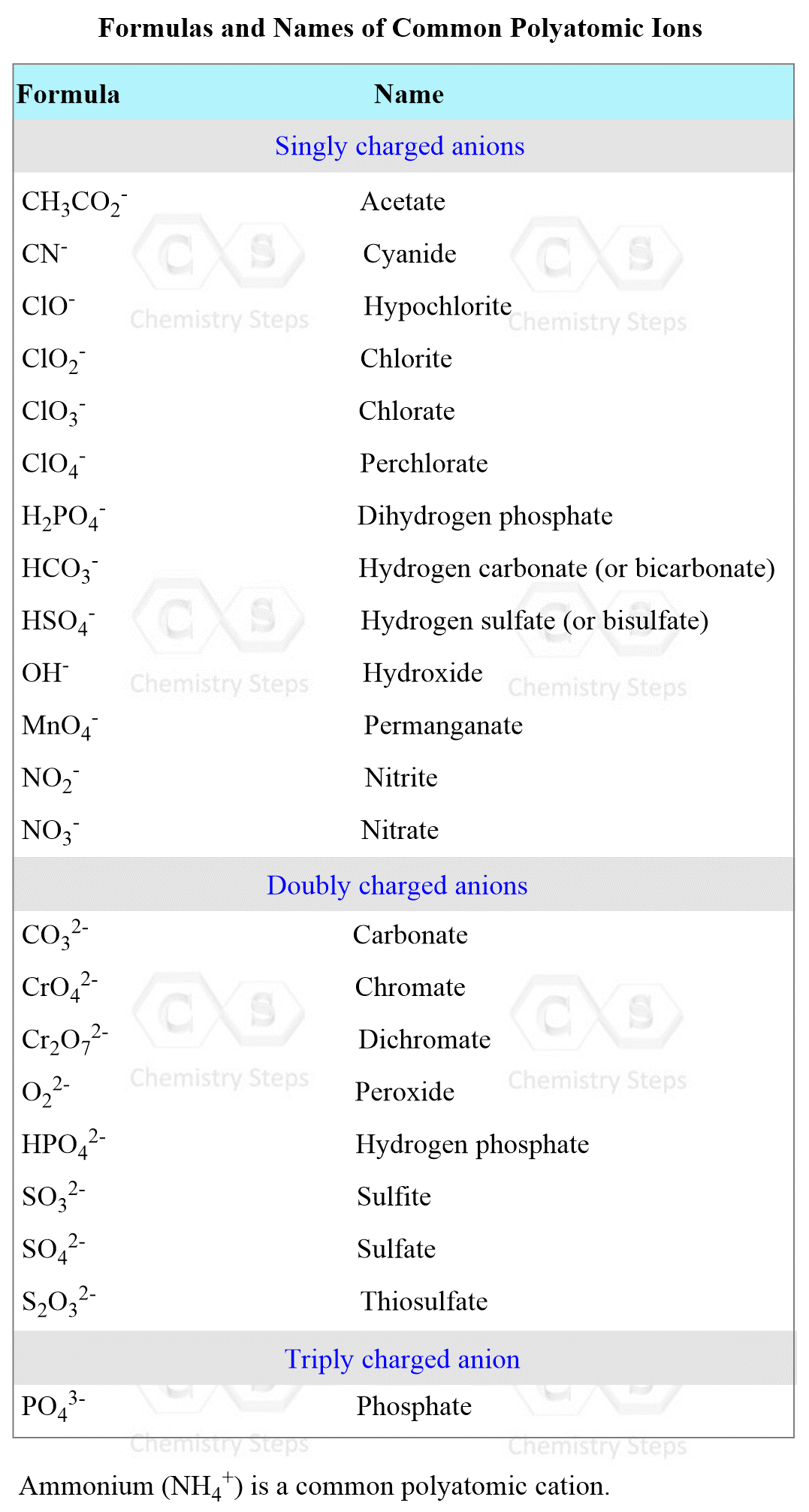
Once we know the charges of the ions, here is what we do:
Complete and balance the following equation between solver nitrate and calcium chloride:
AgNO3(aq) + CaCl2(aq) → ?
1) Exchange the cations and anions. Only carry the subscripts that are part of the formula. I.e., we don’t carry the subscript of Cl, but we do for the nitrate since the formulas are Cl– and NO3–:

2) Place the ionic charges on top of elements and adjust the subscripts:

3) Balance the equation with coefficients and remove the charges:
2AgNO3(aq) + CaCl2(aq) → 2AgCl + Ca(NO3)2
4) Label the soluble compounds as (aq). Determine the precipitate (in this case AgCl) and label it as (s) – solid.
2AgNO3(aq) + CaCl2(aq) → 2AgCl(s) + Ca(NO3)2(aq)
AgCl is a solid (precipitate) because the salts of halides are soluble except when combined with Ag+, Pb2+, and Hg22+.
Acid-Base Reactions as Displacement Reactions
The reaction between acids and bases is also an example of a double-displacement reaction. For example, what products are formed when aluminum hydroxide, Al(OH)3 is reacted with sulfuric acid, H2SO4?
Al(OH)3 + H2SO4 → ?
Al forms the Al3+ ion, and it is going to combine with the anion of the acid – sulfate ion, SO42-.
To predict the formula of the product, write the ions next to each other and move the charges across to add the correct subscripts:
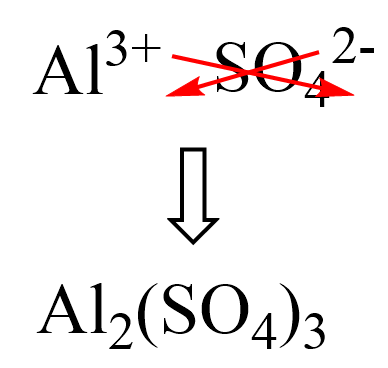
The other product of the reaction is water which forms by combining the H+ and OH– ions.
Al(OH)3(aq) + H2SO4(aq) → Al2(SO4)3(aq) + H2O(l)
In the end, remember to balance the reaction:
2Al(OH)3(aq) + 3H2SO4(aq) → Al2(SO4)3(aq) + 6H2O(l)
There is no precipitate forming in this reaction, however, water can be considered the driving force of the reaction since it is not an ionic compound. Remember, the reactions in aqueous solutions occur if there is a precipitate, gas, or liquid is formed. Otherwise, it will only be a mixture of ions floating in the solution. For example, if we mix MgCl2 with NaNO3, there will simply be Mg2+, Na+, Cl-, and NO3– ions floating in the solution because of the dissociation of the salts.
Being able to predict the products of a reaction is very important partly because it is required for solving problems on determining the amount of the product based on the stoichiometry of the reaction.
Check Also
- Solutions
- Strong and Weak Electrolytes
- Dissociation of Ionic Compounds
- Molecular, Ionic, and Net Ionic Equations
- Molarity
- Dilution
- Ion Concentration
- Definitions of Acids and Bases
- Acid-Base Reactions
- Stoichiometry of Reactions in Aqueous Solutions
- Acid-Base Titrations
- Oxidation State
- Oxidation-Reduction (Redox) Reactions
- Reactions in Aqueous Solutions Practice Problems
Practice
Complete and balance each of the following molecular equations in aqueous solution:
a) AgNO3(aq) + CaCl2(aq) →
b) HNO3(aq) + Na2CO3(aq) →
c) K2CO3(s) + HClO3(aq) →
d) Al(OH)3(s) + HBr(aq) →
e) H3PO4(aq) + Fe(OH)3(s) →
f) BaCl2(aq) + K2SO4(aq) →
